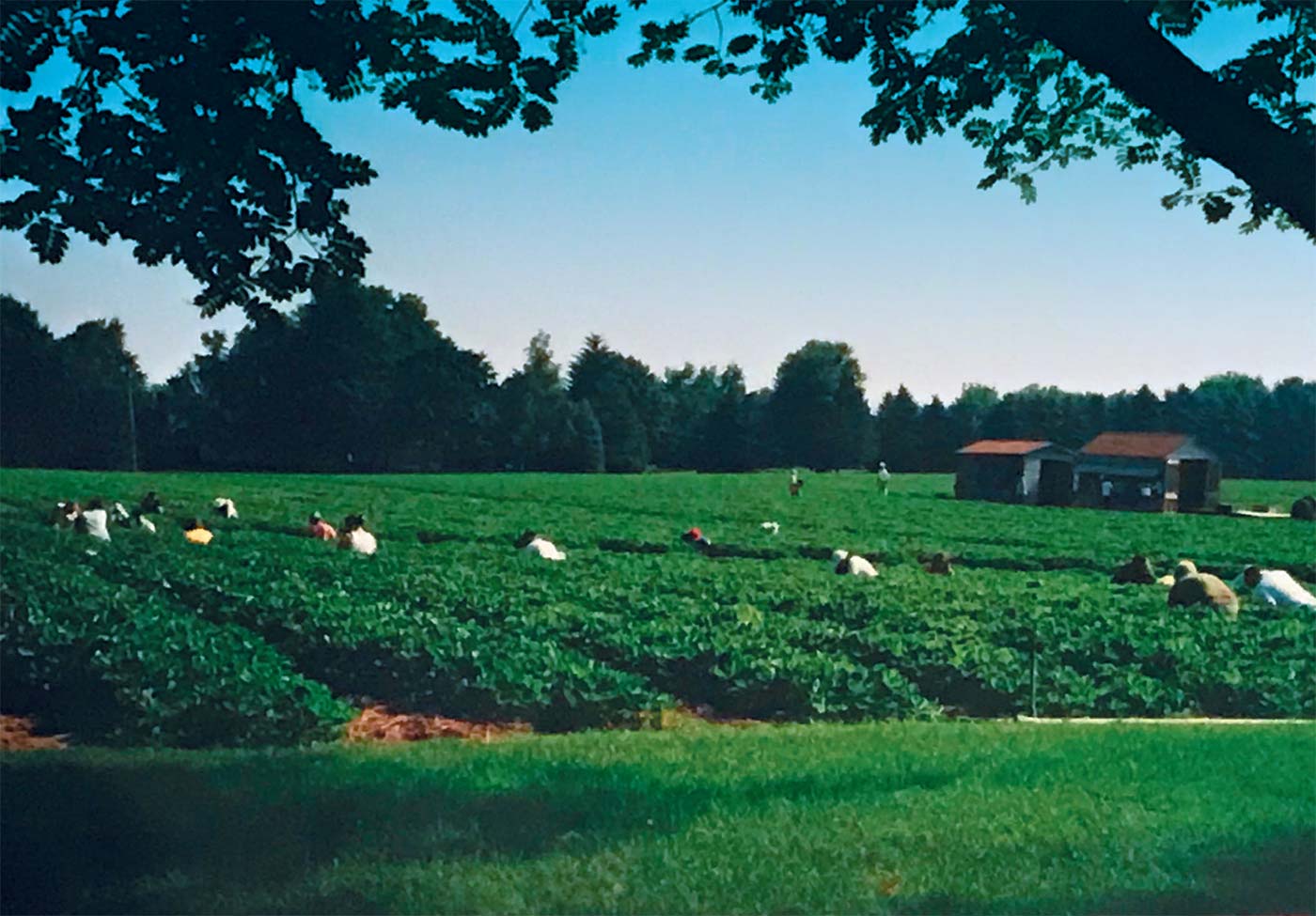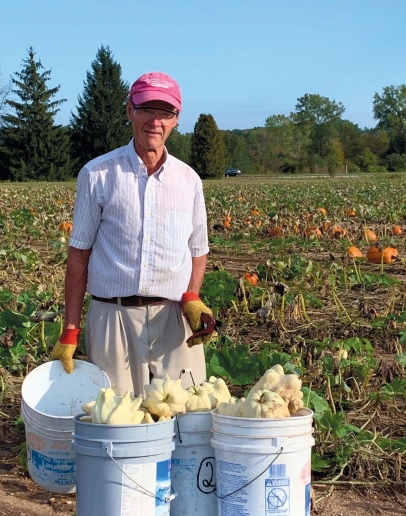Ken Chaudoir: New Crop, Same Green Thumb
Neighbors and highway travelers can often see Ken Chaudoir planting or harvesting in his fields until dusk. First a successful farmer of strawberries, and for the past 13 years a wholesale producer of pumpkins, he is a perfectionist when it comes to implementing learned best practices and to nurturing produce for extraordinary results.
“I’ve always worked outdoors. I still can’t stay inside for too long,” he said.
Chaudoir has worked throughout his lifetime growing seasonal fruit while responsibly managing production to what he and his property can effectively grow and sustain four acres at a time.
A STRAWBERRY SENSATION
Chaudoir grew up learning about every part of the strawberry patch, watching and helping his father, Clarence. Understanding how to take care of the land, deliver a quality product and manage details of a family-owned business were gifts his parents shared with him.
After retiring from the U.S. Coast Guard, Clarence Chaudoir purchased a 12-acre parcel with the vision of turning an apple orchard into a strawberry farm. He cleared the property, established a homestead and each year devoted four acres to production and rotated the remaining acreage. He planted green crops such as oats or winter rye to enhance the soil or to keep weeds and erosion at bay. These practices are still implemented today.
Beginning in 1950 and for 57 continuous years, Chaudoir’s Strawberry Farm, located at the intersection of 18th Avenue and Rhode Island Street in Sturgeon Bay, welcomed customers from mid-June to mid-July, first at a roadside stand and later at a basement pick-up window. Ken’s mother, Ruby, was in charge of sales. The window allowed her to keep house and raise a family while also taking calls and fulfilling orders from the coolness of the lower level of their home.
Whether purchasing quarts or several crates of the sweet, succulent berries, customers walked away with smiles of satisfaction. Many of the immaculately presented and freshly packed red gems never made it to the car. They were difficult to resist. Eating the first strawberries of the season or planning a morning of pick-your-own at Chaudoir’s became an annual event for many customers.
After Ken took over the farm in 1970, he received valuable help during the strawberry season from his two sisters, Emeryl and Marie. He regularly employed up to 30 reliable strawberry pickers and craters each year, and he still reflects on past employees with admiration.
“My entire life I’ve done what I wanted to do, not what I had to do. My occupation allows me to pay the bills, stay active, as well as do what I enjoy,” Chaudoir said. “I can honestly say, I’ve never had a job I didn’t like.”
To this day, people still say they miss Chaudoir’s strawberries.
In 2006, he decided to retire from strawberries following the 2007 season, but that harvest never transpired. Door County received widespread hail at a critical time that in mere minutes destroyed his entire crop. It was an abrupt and unexpected ending to this family’s strawberry business legacy for Ken and a disappointing end for his long-time customers. But resilience seems to be embedded in anyone whose livelihood is subject to the antics of Mother Nature, and Chaudoir knew he was destined to continue working.
Fortunately, 2006 was also the year he planted his first pumpkin seeds.
“Ken’s expertise is knowing how to grow and take care of produce. He is meticulous and passionate about what he does.” – Carrie Lautenbach-Viste, Lautenbach’s Orchard Country Winery
 Chaudoir’s employed a large crew of pickers during the strawberry days. Contributed photo
Chaudoir’s employed a large crew of pickers during the strawberry days. Contributed photo
GROWING PUMPKINS FOR PLEASURE
Chaudoir’s interest in growing a crop he could manage on his own guided him to this new type of seasonal fruit. There was a wholesale market for pumpkins and more than a decade ago he began supplying select area farm markets with his early September through mid-October harvest.
“Ken’s expertise is knowing how to grow and take care of produce. He is meticulous and passionate about what he does,” said Carrie Lautenbach- Viste, owner of Lautenbach Orchard Country Winery in Fish Creek. “Every customer walking through our door experiences a beautiful piece of fruit because of his care.”
Chaudoir has been working part-time for Lautenbach Orchard Country in Fish Creek for six years. In addition to supplying them with pumpkins, he works with the market’s other seasonal produce. One spring day he might be pruning or tying vines in the vineyard. In July he is helping sort and grade cherries. According to Ken, one job seems to lead to another until pumpkin harvest time.
“Pumpkins have a five- to six-week harvest season. They are easy to grow compared to strawberries and do not require nearly as much time and attention,” Chaudoir said. “Because they are a northern tier crop, they do well here and have a fantastic root system. Sometimes they seem to grow overnight.”
He plants his four acres of seed in mid-May by hand. While many commercial growers use machines, he carefully distances the seeds four to six feet apart to accommodate their vines and expected size at maturity. After giving new plants a month or so to grow, he walks the fields again. He looks for proper spacing and thins the plants, if needed. Until the time the vines begin to spread, he cultivates his crop for weeds every couple weeks, covering each acre.
This past year, Chaudoir grew 35 different varieties of pumpkins. His are more of a specialty item than the traditional orange. Individual characteristics might include a unique color – like his yellow, white, pink, brown, black and “blue” (actually having a gray hue) pumpkins or have attributes that comprise a certain texture, smoothness or size. Almost all are used for decorating homes and businesses, both indoors and out “I try to have something for everyone,” Chaudoir said.
Every year he sells approximately 90-100 percent of the saleable crop. Sometimes pumpkins are not saleable because they are deformed, the color may be off or wildlife may have taken a bite out of them. By the time he delivers them to market, he has touched each pumpkin about four different times. Picking, cleaning, sorting and delivering all take time and care and he does this by himself. At age 71, he affirms that his back is the beneficiary of his physical work and it never feels better than early fall when it is getting its best workout.
“Just seeing him work on lining up the pumpkins at our market, you can tell he loves what he does and takes pride in his work,” Lautenbach- Viste said.
In September he plants his winter crops, and in November he chops and discs the pumpkin field and the leftover plants return to the earth that sprouted them.
Chaudoir’s only off-season is winter. Ice fishing is his favorite hobby. When not fishing, he’s busy researching new pumpkin assortments, scanning the pages of seed catalogs that arrive at his home from around the country. He works with select providers and new pumpkin varieties are developed every year.
“If it looks interesting,” Chaudoir said, “I’ll give it a try.”
There are always resources to help you if you wish to grow something, according to Chaudoir. Some of the most valuable groups to connect with include growers’ associations that usually meet in the winter months, as well as county agricultural agents who can help select crops that will be successful in our climate and test soil compatibility to plants. “There’s nothing quite like talking to a grower to find out valuable tips on how to do things,” Chaudoir added.
It is good advice that he continues to use.





